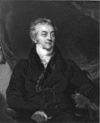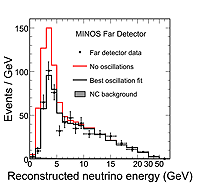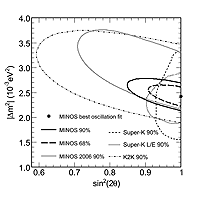Neutrino: Wave or particle?
The MINOS experiment has shown that as neutrinos oscillate from one type to another they act a lot like waves. The experiment, which sends a beam of neutrinos from Fermilab to a detector in northern Minnesota, confirmed in 2006 the Super Kamiokande discovery that neutrinos disappear in flight. Now, MINOS confirmed that the neutrinos’ disappearance arises from the wave phenomenon of oscillations.
 |
| Thomas Young, an English scientist. |
MINOS is a large-scale replay of Thomas Young’s famous 1801 double slit experiment. Young was then in a debate with Isaac Newton about whether light is a wave or a particle. Particles, when added together, give us more particles. Waves, when added together, can add to each other or cancel one another out to give us nothing. (Think of noise-canceling headsets.)
Young’s experiment passed light through slits in a pair of barriers (see figure at right, below). The first barrier’s single slit (a) gave a source of light. The second barrier’s two slits (b) created two light beams from that source. If light is a wave, those two beams when combined could either add to or cancel one another on their paths to a screen. Thus, an observer at a remote location (d) might see either bright light or no light at all. The interference pattern that Young observed seemed to confirm that light is indeed a wave.
The neutrinos in the MINOS experiment show a similar wave behavior to Young’s experiment. Neutrinos produced or detected in experiments are one of three types, the electron neutrino, νe, muon neutrino, νµ, or tau neutrino, νt. The MINOS experiment begins with a source of muon neutrinos.
A "neutrino slit experiment" occurs because another way to describe these obscure particles is by how massive they are. Since neutrinos have mass, they could also be labeled as ν 1, ν2, ν3 (light, middle, heavy). The individual mass states cannot be detected in nature, and any muon neutrino produced in a neutrino beam is really a superposition of all three mass types. By the time the neutrinos arrive at the MINOS detector in Minnesota they add up in different ways - like the light waves in Young's experiment - and are observed - as either νe, νµ, or νt. Because the MINOS detector sees only muon neutrinos, those neutrinos that combine as either electron or tau neutrinos appear to be lost, resulting in a deficit of muon neutrinos.
 |
|
In its new article, published in Physical Review Letters, MINOS described its observation of about 848 observed muon neutrino events in the far-away detector. While that’s a lot for these elusive particles, it falls short of the 1065 events expected if all muon neutrinos from the beam arrived undeterred. Further, the energy spectrum of the surviving neutrinos (see plot at left) bears a resemblance to Young’s double-slit experiment: Neutrinos at some energies survive the 735 km trip just fine, while others at specific energies cancel one another. The observed deficit, furthermore, is now precisely measured to the point that other explanations for why some neutrinos disappear in flight (decay to other exotic particles, for example) appear less likely.
 |
| The graph shows the difference in mass of two of the three neutrino eigenstates. |
It’s been more than 200 years since Thomas Young thought he settled the score on whether light is a wave or a particle. With the advent of quantum mechanics, we now know that light and many phenomena can be described both ways. With the recent MINOS article, neutrino particles are shown to have both particle and wave properties, and the experiment is using that wave particle duality to reveal the mass of nature’s most enigmatic particle.
Result of the Week Archive
|